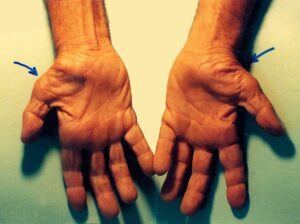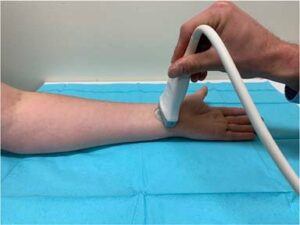Carpal Tunnel Syndrome (CTS) Hand Physiotherapy
Carpal tunnel syndrome happens when the median nerve in the middle of the wrist gets compressed, causing numbness, tingling and loss of strength. The carpal tunnel is a very small and narrow tunnel (about 2 cm width) in the wrist, with NINE flexor tendons and a median nerve that runs through it.
That means it’s pretty compact.
The main purpose of the median nerve and tendons are to provide
- movement, strength, fine motor movements and function
- sensations and feelings such as temperature, touch, sensory input
from the thumb to the long half of the ring finger.
Contents
Causes of carpal tunnel syndrome
Basically, whenever the median nerve is compressed in the carpal tunnel, it’d cause carpal tunnel syndrome. This can is usually caused by swelling in the wrist due to injury or disease – because the carpal tunnel is so tight, even small injuries can cause carpal tunnel syndrome fairly easily.
Most of the time, it’s caused by either:
- Repetitive strain injuries, where patients consistently or repeatedly lift, grip or pull items as part of their work, responsibilities or hobby. Hobbies can be weight lifting, racquet games. Work can be gardening, butchery. Responsibilities can include caring for kids and elderly.
- Direct trauma, such as in accidental or sports, such as falling and hitting the wrist on hard surface, or being hit by a motorbike at the wrist
Symptoms of carpal tunnel syndrome
Patients usually start off with mild on-off tingling and numbness in the
- thumb
- index finger
- middle finger
- long half of ring finger
- or all of the above
upon waking up or working on a task / project; which they will ignore or try to “shake it off”, thinking that it’s just sore because it’s tired. That isn’t entirely wrong, so if the tingling goes away, then it’s not an issue.
It becomes an issue when the tingling and numbness starts to become
- more frequent
- shorter time to tingling eg last time can work 60 minutes before tingling comes in, but eventually the time becomes shorter and shorter, even immediate
- lasts longer and longer
- more intense such they cant shake it off
At moderate to severe stages, the symptoms can be present all the time, and they cannot use their fingers properly eg
- coins fall out of their hands
- cant use keys to lock or unlock doors
- cant zip / unzip or button / unbutton
basically use of fingers and thumb can become very very hard.
Potential irreversible permanent nerve damage

I dont recommend patients to ignore carpal tunnel syndrome, because
- firstly, it’s something that can be treatable, especially in the early to middle stages
- secondly, there is a potential permanent nerve damage if left untreated
Yeah, it’s not nice news, but I’d rather tell you upfront so you know what you can prevent. If you look at the image here, the blue arrows point to the sunken parts of the thumb muscles, and what it’s pointing at is muscle atrophy.
Atrophy means shrinkage, and this is caused by decrease of median nerve activation of the thumb (thenar) muscles, combined with less use and prolonged rest, causing the muscle to shrink. When this happens, it’s near impossible to turn it around (though it’s possible to improve to an extent if we catch it earlier).
Other permanent symptoms that can develop with long term non-treatment of carpal tunnel syndrome:
- shrinkage/wastage of the muscles in the hand and wrist that are innervated by the median nerve (basically weak to very weak pinch, grasp, use of the thumb, index finger, middle finger)
- sensory loss and abnormalities (numbness, tingling, pins and needles, etc)
Aggravating factors of carpal tunnel syndrome
Some medical conditions that may aggravate carpal tunnel syndrome includes:
- arthritis
- overweight / obesity
- trauma and force
- diabetes
- hypothyroidism
Other causes are internal factors that increase the pressure inside the carpal tunnel, as well as external factors that cause pressure from outside the tunnel, such as the presence of ganglions etc.
Other contributing factors of CTS
#1 Genetics and DNA
Unfortunately, some people are really more at risk to developing carpal tunnel syndrome due to genetic (inherited) factors, which is not possible to change. The only way is to be more mindful of it and to work around it
#2 Pregnancy
Some pregnant ladies (congratulations!) seem to be more at risk of developing carpal tunnel syndrome.
How hand therapists / physiotherapists can help

Some of the interventions for carpal tunnel syndrome includes:
- customized wrist splinting to protect the wrist from too much flexion movement as well as help offload the pressure and strain in the carpal tunnel
- gentle progressive protected tendon and nerve glide mobilization to ensure tendon and nerve is healthy
- ultrasound therapy to accelerate soft tissue healing of the compressed nerve as well as any injured tendons
- etc
Where To Next?
- Go to Home / Start
- Learn and find out more about your pains (bones, muscles, joints, tendons, ligaments, nerves etc) at Pain Conditions & Injuries
- Visit our shop to see products we recommend for pain relief, heating, treatments and more
- Contact us






